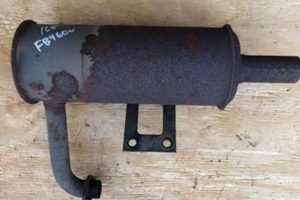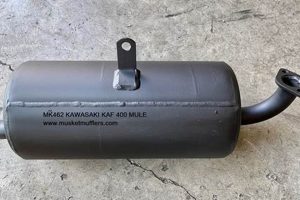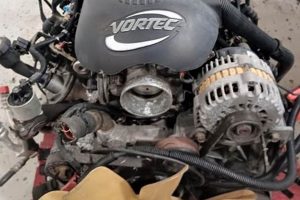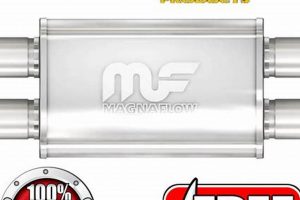A heat-resistant, adhesive-backed material designed for temporary repairs to exhaust systems. This product, often available at automotive retail locations, typically comprises a fiberglass or foil base coated with a high-temperature adhesive. It is intended to seal small holes and cracks in mufflers and exhaust pipes, mitigating noise and preventing exhaust leaks as a short-term solution. For instance, if a vehicle’s muffler develops a small rust hole, this tape can be applied to cover the damaged area until a more permanent repair can be performed.
The application of this specialized tape provides several immediate advantages. It reduces exhaust noise, thereby improving the driving experience. More importantly, it minimizes the risk of dangerous exhaust fumes entering the vehicle’s cabin. Historically, individuals have employed various improvised methods to address exhaust system leaks. This product offers a more reliable and readily available alternative, extending the life of the exhaust system until a proper replacement or welding repair can be scheduled. However, its limitations must be understood, as it is not a substitute for a comprehensive exhaust system repair.
The following sections will delve into the correct application methods, lifespan expectations, alternative repair options, and safety precautions associated with utilizing temporary exhaust system repair solutions. This comprehensive overview will provide a thorough understanding of the considerations involved in managing exhaust system issues.
Application Guidance
Effective utilization of temporary exhaust repair solutions requires adherence to specific guidelines. Proper application maximizes the product’s effectiveness and prolongs its lifespan.
Tip 1: Surface Preparation is Paramount. Thoroughly clean the affected area of the exhaust system. Remove rust, dirt, and grease using a wire brush and degreaser. A clean surface ensures optimal adhesion.
Tip 2: Apply to a Cool Exhaust System. Ensure the exhaust system is completely cool before applying the tape. Applying to a hot surface can cause the adhesive to fail prematurely and may present a burn hazard.
Tip 3: Overlap Each Layer. Wrap the tape tightly around the damaged area, overlapping each layer by at least 50%. This creates a secure and robust seal.
Tip 4: Use Multiple Wraps. For significant damage, apply multiple layers of the tape to ensure adequate coverage and reinforcement. The number of layers depends on the severity of the damage.
Tip 5: Secure the Ends. Firmly press the ends of the tape down to prevent them from peeling up. This helps maintain a tight seal and extends the tape’s lifespan.
Tip 6: Allow Curing Time. After application, allow sufficient curing time as specified by the manufacturer before operating the vehicle. This allows the adhesive to fully bond to the exhaust system.
Tip 7: Monitor the Repair Regularly. Periodically inspect the taped area for any signs of deterioration, such as peeling, cracking, or exhaust leaks. Promptly address any issues to prevent further damage.
Adhering to these application tips will enhance the effectiveness of temporary exhaust repairs, providing a more reliable and longer-lasting solution. This can contribute to a safer and quieter driving experience until permanent repairs can be undertaken.
The subsequent sections will cover alternative repair methods and elaborate on safety considerations during the application process.
1. Temporary exhaust sealing
Temporary exhaust sealing addresses the immediate need to mitigate leaks and noise from compromised exhaust systems. This approach provides a short-term solution while a more permanent repair or replacement is scheduled. The effectiveness of temporary sealing is directly related to the application of appropriate materials and techniques, including the utilization of specialized tapes.
- Material Properties and Heat Resistance
The success of temporary sealing hinges on the material’s ability to withstand high exhaust gas temperatures. Specialized tapes, like those available at automotive retailers, are designed with high-temperature adhesives and heat-resistant substrates, such as fiberglass or aluminum foil. Failure to use materials with adequate heat resistance results in premature degradation and seal failure. The performance under these conditions dictates the lifespan of the temporary repair.
- Application Technique and Surface Preparation
Optimal sealing performance requires meticulous surface preparation. Removal of rust, dirt, and grease from the damaged area ensures proper adhesion of the repair material. The correct application technique, including overlapping layers and firm adherence to the manufacturer’s instructions, is essential for creating a robust seal. Inadequate preparation or improper application diminishes the effectiveness of the temporary fix, potentially leading to recurring leaks.
- Lifespan and Limitations of Temporary Seals
Temporary exhaust sealing solutions offer limited durability. Factors such as exhaust system vibration, fluctuating temperatures, and exposure to road debris contribute to the degradation of the seal over time. While providing an immediate remedy, these repairs are not intended as permanent fixes. Regular inspection is crucial to monitor the seal’s integrity and ensure timely scheduling of a comprehensive repair or replacement. The economic advantage gained through temporary solutions buys time without significant financial investment.
- Safety Considerations and Exhaust Fume Mitigation
Temporary sealing methods help minimize the risk of harmful exhaust fumes entering the vehicle’s cabin. Exhaust fumes contain carbon monoxide, a colorless and odorless gas that can be fatal. A compromised exhaust system increases the potential for fume exposure. While temporary repairs can reduce this risk, they should not be considered a complete safety measure. Professional inspection and repair remain necessary to ensure a safe driving environment.
The efficacy of temporary exhaust sealing is intrinsically linked to the selection of appropriate materials and adherence to proper application techniques. Understanding the limitations and prioritizing safety are paramount considerations when employing these methods. While products offer a practical short-term solution, professional assessment and repair remain crucial for long-term exhaust system integrity and safety.
2. Heat resistance requirement
The efficacy of exhaust repair solutions is fundamentally determined by their ability to withstand elevated temperatures. Exhaust systems routinely operate at temperatures that can exceed several hundred degrees Fahrenheit. Consequently, any material employed for temporary or permanent repairs must possess inherent heat resistance properties. The absence of this characteristic results in premature degradation of the repair, negating its intended function. Products lacking sufficient thermal stability become brittle, lose adhesion, and ultimately fail to contain exhaust leaks, rendering them ineffective. The heat resistance factor is a critical performance parameter.
Specifically, the effectiveness of temporary exhaust repair tapes hinges on the adhesive’s ability to maintain its bonding strength and the tape’s structural integrity under high-temperature conditions. Tapes available at retail locations are formulated with adhesives and substrate materials designed to meet these criteria. For instance, tapes incorporating fiberglass or aluminum foil offer enhanced heat resistance compared to conventional adhesive tapes. However, even these specialized tapes have temperature limitations, typically specified by the manufacturer. Exceeding these limits results in reduced lifespan and compromised performance. Understanding and adhering to the manufacturer’s temperature specifications are essential for maximizing the lifespan and effectiveness of the repair.
In conclusion, the connection between heat resistance and exhaust repair materials is inextricable. The suitability of these products is fundamentally dependent on their ability to withstand the harsh thermal environment of the exhaust system. Prioritizing the heat resistance requirement ensures the reliability and longevity of the repair, contributing to improved vehicle performance and safety until a permanent solution can be implemented. Therefore, the selection process must prioritize materials with appropriate thermal properties to guarantee satisfactory and safe vehicle operation.
3. Application surface preparation
Effective application of temporary exhaust repair solutions, such as heat-resistant tape commonly available at automotive retailers, is directly contingent on the quality of surface preparation. The tape’s adhesive is designed to create a bond with the substrate of the exhaust system. However, the presence of contaminants, such as rust, grease, dirt, or loose paint, disrupts this bonding process. These contaminants form a barrier between the adhesive and the metal, preventing the formation of a strong, durable seal. The result is premature failure of the tape, rendering the temporary repair ineffective. For example, attempting to apply tape directly to a rusted muffler without removing the rust will yield a weak bond that is likely to detach quickly.
The recommended procedure for surface preparation involves several steps. First, a wire brush should be used to remove loose rust and debris from the damaged area. Next, a degreaser should be applied to eliminate any oil or grease. Finally, the area should be wiped clean with a dry cloth to remove any residual cleaning agents. This process creates a clean, dry surface that is conducive to optimal adhesion. Skipping any of these steps can compromise the integrity of the repair. Consider a scenario where grease is present on the muffler surface; the tape’s adhesive would bond to the grease, rather than the metal, resulting in a weak and easily compromised seal. Proper surface preparation is, therefore, not merely a recommendation but a prerequisite for a successful temporary exhaust repair.
In summary, application surface preparation represents a critical component of utilizing temporary exhaust repair solutions. Neglecting this step significantly reduces the likelihood of a successful and long-lasting repair. The practical significance of this understanding lies in its impact on the effectiveness and longevity of the temporary fix. By adhering to the recommended surface preparation procedures, individuals can maximize the potential of such repair methods, ensuring a safer and quieter driving experience until a permanent solution can be implemented.
4. Lifespan Limitations
The service life of temporary exhaust repair solutions, including tapes commonly found at automotive retail outlets, is inherently limited. This limitation stems from the harsh operating environment of exhaust systems. Factors such as extreme temperature fluctuations, constant vibration, exposure to corrosive elements (road salt, water), and physical impacts from road debris collectively contribute to the degradation of these temporary fixes. Consequently, materials applied as temporary repairs are not designed to provide a permanent solution and will eventually fail. Consider a vehicle driven daily through winter conditions where road salt accelerates corrosion; the lifespan of the repair tape would be substantially reduced compared to a vehicle operating in a dry, temperate climate. Understanding this inherent limitation is crucial for managing expectations and planning for permanent exhaust system repairs.
The primary reason for this limited lifespan lies in the material properties of temporary repair products. The adhesives used in repair tapes, while designed for high-temperature resistance, gradually lose their bonding strength over time due to thermal cycling and exposure to chemical contaminants. The substrate materials, such as fiberglass or aluminum foil, can also become brittle and crack, particularly under constant vibration. Furthermore, the application process itself introduces potential weaknesses. Imperfect surface preparation or improper tape application can accelerate the degradation process. A real-world example involves a vehicle with an exhaust leak near a weld; the weld’s rough surface makes it difficult to achieve a complete seal with the repair tape, leading to premature failure. The understanding of these material and application-related factors highlights the importance of regular inspection of the temporary repair.
In conclusion, the lifespan limitations of temporary exhaust repair tapes are an unavoidable consequence of the materials used and the harsh operating conditions. While these products offer a cost-effective and convenient means of addressing minor exhaust leaks, they should be viewed as a stopgap measure until a permanent solution can be implemented. Regular inspection is essential to monitor the condition of the repair and prevent further damage or safety risks associated with exhaust leaks. Ignoring these limitations can lead to increased noise, reduced fuel efficiency, and potential exposure to harmful exhaust fumes, underscoring the need for timely and comprehensive exhaust system maintenance.
5. Cost-effectiveness assessment
Evaluating the economic viability of temporary exhaust repair solutions, such as tapes available from automotive retailers, involves a thorough analysis of both immediate costs and potential long-term consequences. This assessment considers not only the initial purchase price but also the durability of the repair and the potential for preventing more extensive damage.
- Initial Investment vs. Professional Repair
The primary advantage of using repair tape lies in its significantly lower upfront cost compared to a professional exhaust system repair or replacement. A roll of tape typically costs a fraction of what a mechanic would charge for welding or installing a new component. However, this cost saving is offset by the limited lifespan of the temporary repair and the potential for further damage if the underlying issue is not addressed. For example, postponing a necessary welding repair due to a tape fix might lead to increased corrosion and eventual component failure, resulting in a more expensive repair in the long run.
- Lifespan and Frequency of Reapplication
The cost-effectiveness equation is further complicated by the need for frequent reapplication of the repair tape. As previously noted, the tape’s lifespan is limited by environmental factors and the inherent stresses of the exhaust system. If the tape requires replacement every few weeks or months, the cumulative cost can quickly approach or even exceed the cost of a single professional repair. Consider a scenario where the tape needs to be reapplied monthly; within a year, the total cost might surpass that of a welding repair, while still not resolving the root cause of the problem.
- Potential for Damage Mitigation
One potential benefit of using repair tape is its ability to prevent minor leaks from escalating into more significant problems. Sealing a small hole or crack in the exhaust system can prevent further corrosion and minimize the risk of damage to other components. In this context, the tape acts as a preventive measure, potentially saving money on future repairs. However, this benefit is contingent upon the tape being applied correctly and monitored regularly. If the leak is not properly sealed, or if the tape is allowed to deteriorate without replacement, the potential for damage mitigation is lost.
- Labor Costs and DIY Considerations
Applying repair tape is typically a do-it-yourself (DIY) task, eliminating the need for professional labor costs. This is a significant factor in the cost-effectiveness assessment, particularly for individuals who are comfortable performing basic automotive maintenance. However, it is important to consider the value of one’s time and the potential for errors. Incorrect application of the tape can lead to premature failure and negate any cost savings. Furthermore, performing DIY repairs may void certain warranty agreements. The ease of DIY application is an advantage if done correctly, but this needs to be balanced against the potential risks of improper use.
Ultimately, the cost-effectiveness of utilizing repair tape for exhaust systems hinges on a careful consideration of these factors. While the initial investment is low and DIY application is feasible, the limited lifespan and potential for further damage must be weighed against the cost of a professional repair. The decision-making process requires assessing the severity of the exhaust leak, the vehicle’s overall condition, and the individual’s skill and comfort level with automotive maintenance. A balanced approach that considers both short-term savings and long-term costs is essential for making an informed decision.
Frequently Asked Questions About Exhaust Repair Tape
The following questions address common concerns and misconceptions regarding the use of exhaust repair tape for temporary exhaust system fixes. The information aims to provide clarity and guidance on the appropriate application and limitations of this product.
Question 1: What is the expected lifespan of exhaust repair tape?
The service life of exhaust repair tape is inherently limited. Exposure to high temperatures, vibration, and road debris degrades the adhesive and substrate, typically resulting in failure within a few weeks to a few months. This should be considered a temporary solution only.
Question 2: Is surface preparation truly necessary before applying exhaust repair tape?
Thorough surface preparation is essential for proper adhesion. Removal of rust, dirt, and grease ensures a strong bond between the tape and the exhaust system. Neglecting this step will significantly reduce the tape’s effectiveness and lifespan.
Question 3: Can exhaust repair tape be used on any part of the exhaust system?
Exhaust repair tape is primarily intended for use on the muffler and exhaust pipes. It is not suitable for repairing catalytic converters, oxygen sensors, or other sensitive components. Consult a professional for repairs to these parts.
Question 4: How many layers of exhaust repair tape should be applied?
Multiple layers, with significant overlap, are recommended for creating a secure seal. The exact number of layers depends on the size and severity of the damage, but at least two to three layers are typically necessary for adequate coverage.
Question 5: Is it safe to drive a vehicle with an exhaust leak temporarily repaired with tape?
While exhaust repair tape can temporarily reduce exhaust leaks and noise, it does not eliminate the risk of harmful exhaust fumes entering the vehicle cabin. Regular monitoring is critical. Seek professional repair as soon as possible.
Question 6: Can exhaust repair tape be considered a permanent fix for exhaust system damage?
Exhaust repair tape is designed as a temporary measure only. It is not a substitute for welding, component replacement, or other professional repair methods. The tape’s limited lifespan and susceptibility to environmental factors preclude its use as a long-term solution.
The proper application and understanding of the limitations of exhaust repair tape are crucial for safe and effective use. This product should be viewed as a short-term remedy, not a permanent solution, for exhaust system issues.
The following sections will detail alternative repair solutions and further safety precautions associated with exhaust system maintenance.
Concluding Remarks on Temporary Exhaust Repairs
This exploration has outlined the characteristics, application, limitations, and cost considerations surrounding temporary exhaust repair solutions, with a focus on products, such as autozone muffler tape, commonly available to consumers. The analysis emphasizes the importance of proper surface preparation, material selection, and an understanding of the product’s intended lifespan. While offering a short-term solution to mitigate noise and leaks, these temporary measures are not a substitute for professional assessment and repair.
Given the potential risks associated with exhaust leaks, including exposure to harmful fumes and the possibility of further component damage, a proactive approach to vehicle maintenance is paramount. Temporary fixes, including the application of autozone muffler tape, should be viewed as interim measures while permanent repairs are scheduled and executed. Prioritizing safety and consulting qualified professionals ensures long-term vehicle integrity and occupant well-being. Therefore, schedule a visit with your trusted mechanic as soon as possible.







